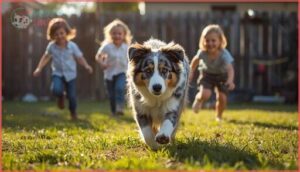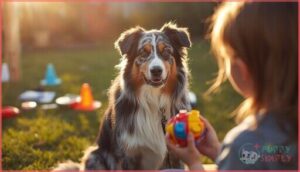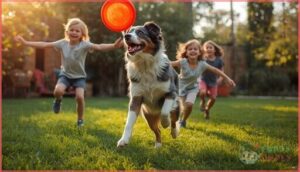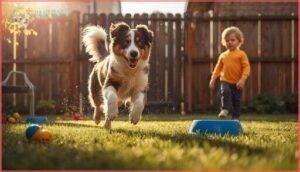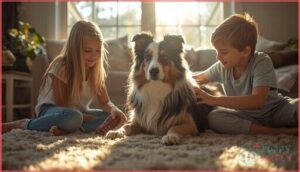This site is supported by our readers. We may earn a commission, at no cost to you, if you purchase through links.
Your seven-year-old races through the backyard, and suddenly your Australian Shepherd darts in front of her, circling back to redirect her path. That herding instinct kicks in fast, and it can look concerning if you don’t know what you’re watching.
Australian Shepherds can be wonderful companions for kids, but their breed-specific behaviors require understanding and management. These intelligent, energetic dogs form deep bonds with their families and often take a protective role with children.
However, their need for daily exercise, mental challenges, and consistent training means they’re not the right fit for every household. You’ll want to think about your family’s activity level, your children’s ages, and your commitment to training before bringing one home.
Table Of Contents
- Key Takeaways
- Are Australian Shepherds Good With Kids?
- Key Traits That Affect Child Interactions
- Benefits of Raising Australian Shepherds With Kids
- Potential Challenges and Safety Tips
- Best Practices for Successful Integration
- Frequently Asked Questions (FAQs)
- How can I prevent my Australian Shepherd from jumping on kids or other people?
- What age children are best for Australian Shepherds?
- Can Australian Shepherds live in small apartments with kids?
- How do Australian Shepherds react to babies and toddlers?
- Do Australian Shepherds get along with other family pets?
- Conclusion
Key Takeaways
- Australian Shepherds can be excellent family dogs for active households, but their strong herding instincts may lead to nipping at children’s heels, requiring early training and consistent supervision to redirect these behaviors safely.
- These high-energy dogs need 60 to 90 minutes of daily exercise and mental stimulation through activities like fetch, agility training, or puzzle toys to prevent boredom and destructive behaviors around kids.
- School-age children (6-12 years old) are the best match for Australian Shepherds since they can understand boundaries, participate in structured activities, and help with daily care responsibilities that teach compassion and accountability.
- Successful integration requires early socialization between 3-12 weeks, positive reinforcement training, teaching children to recognize dog body language, and creating designated safe spaces where the dog can retreat when overwhelmed.
Are Australian Shepherds Good With Kids?
Australian Shepherds have a reputation for being great family dogs, but there are a few things to keep in mind when kids are involved.
Their personality and behavior can make a big difference in your household. Let’s look at what you can expect when raising an Aussie around children.
Typical Temperament Around Children
Even if your kids are bouncing off the walls, Australian Shepherds tend to match their Playful Energy with a Gentle Nature that’s hard to beat. Their temperament leans toward an affectionate nature and Family Loyalty, making them standout family dogs.
Thanks to their Protective Instincts, Aussies usually keep a close eye on children, promoting child safety and genuine Child Friendship. Australian Shepherds thrive with daily exercise needs that support their overall well-being and family integration.
Protective and Playful Behavior
You’ll notice Australian Shepherds bring a mix of Alert Barking and Gentle Play to family life. Their Herding Instincts keep kids in their sights, while high Energy Levels mean they’re always up for fun. Watch out for Rough Play, especially with younger kids. They’re known for their gentle and friendly nature.
Here’s what families love:
- Loyal watchdogs
- Playful dogs
- Child safety
- Endless entertainment
Loyalty and Family Bonding
That playful energy naturally leads to deep loyalty—Australian Shepherds are true “Velcro Dogs,” always wanting to stick close. Their pack mentality means your family becomes their world. Emotional sensitivity helps them tune into your moods, while protective instincts keep watch over kids. With strong training impact, socialization shapes these family pets into loving, trustworthy companions.
| Pack Mentality | Emotional Sensitivity | Training Impact |
|---|---|---|
| ————–: | : | |
| ——————–: | : | |
| —————: | ||
| Stays close | Reads family moods | Builds trust |
| Guards kids | Bonds deeply | Shapes behavior |
| Loyal pet | Seeks connection | Fosters safety |
Key Traits That Affect Child Interactions
Australian Shepherds bring a lot of personality and energy to family life, especially around kids. Certain traits play a big role in how they interact with children. Let’s look at what matters most when you’re thinking about this breed for your family.
Herding Instincts and Children
Ever noticed your Aussie circling kids like a sheepdog at work? That’s their herding instincts in action. While Herding Behavior is fascinating, it can spark Child Safety concerns—especially with Nipping Issues. In daily Household Dynamics, watch for:
- Chasing running children
- Nipping at heels
- Intense staring
- “Bossy” behavior
- Herding Dog Breeds’ playful control
Early Canine Socialization helps keep Child and Dog Interactions safe.
Energy Levels and Play Requirements
Australian Shepherds have high energy levels, needing 60 to 90 minutes of exercise daily. Walks aren’t enough—mix in fetch, swimming, or agility games.
These activity types do more than burn energy; they boost mental stimulation and prevent boredom. Regular play meets their play requirements and encourages family bonding, especially with kids who love active, outdoor fun.
Intelligence and Trainability
Brains and energy go hand in hand here. With strong intelligence and natural problem-solving skills, your Australian Shepherd learns quickly, especially with positive dog training and obedience training.
Short, focused sessions work best for their cognitive development. Use varied learning strategies and plenty of mental stimulation—like puzzle toys or trick training—to keep their trainability sharp and prevent boredom around your kids.
Benefits of Raising Australian Shepherds With Kids
Raising Australian Shepherds alongside kids can bring plenty of rewards to your family life. These energetic dogs often help children grow in more ways than one.
Here’s how having an Aussie around can make a difference for your kids.
Teaching Responsibility and Compassion
Did you know that raising kids with pets like Australian Shepherds can spark real growth in responsibility and compassion? When your child helps with pet care roles—feeding, brushing, or gentle training—they’re learning social skills and cognitive skills firsthand.
Educator roles at home matter too; modeling responsible pet ownership weaves social learning and child safety around dogs into everyday family dynamics.
Encouraging Outdoor Activity
Looking for a way to get your kids off the couch? With a High-Energy Dog like an Australian Shepherd, Outdoor Play becomes the norm. You’ll see your family hiking, tackling Backyard Games, and enjoying Nature Walks together. Active Families benefit most, especially when Pet Exercise is woven into daily life. Here’s what you can expect:
- Daily exercise routines
- Family hiking adventures
- Backyard Games galore
- Nature Walks
- Kids joining Pet Exercise
Emotional Support and Companionship
Ever noticed how some family pets just “get” you? With their empathetic nature and emotional intelligence, these companion animals offer more than cuddles—they help with Anxiety Reduction and Trauma Recovery for kids.
Their affectionate nature and loyalty bring real Emotional Stability, making them therapeutic benefits in your home. That’s why Australian Shepherds shine as loving, emotionally supportive family pets.
Potential Challenges and Safety Tips
Raising an Australian Shepherd with kids comes with a few hurdles you’ll want to keep in mind. It’s important to know what challenges might pop up so you can keep everyone safe and happy.
Here’s what you should watch for as you welcome this energetic breed into your family.
Managing Herding and Nipping Behaviors
Ever seen your Aussie try to “herd” the kids like sheep? That’s their breed temperament at work. Herding control and nipping prevention start with clear training techniques—think basic commands, structured play, and positive reinforcement.
Behavioral modification is key: redirect herding instincts with toys and supervised activities.
Raising dogs with children means teaching both sides about safe animal behavior and respectful dog behavior.
Allergy Considerations and Grooming Needs
Beyond behavior, there’s grooming to think about. Australian Shepherds shed heavily year-round—especially during spring and fall—which means daily brushing and regular baths help with dander control and allergy prevention.
If your kids have sensitivities, invest in quality grooming tools like undercoat rakes and air purifiers. Consistent coat health routines keep allergens down and your home more comfortable for everyone.
Supervising Play and Preventing Accidents
Even with grooming managed, active play brings its own risks. Continuous supervision prevents herding nips and keeps excitement from escalating.
Early socialization and training teach your Australian Shepherd gentle behavior around kids, while baby gates create safe retreat spaces.
Studies show supervised play cuts injury severity by 60%, so stay present during family roughhousing and redirect herding instincts into fetch or puzzle toys.
Supervised play reduces injury severity by 60%, so stay present and redirect herding instincts into appropriate activities
Best Practices for Successful Integration
Bringing an Australian Shepherd into a home with children doesn’t have to feel overwhelming. With the right approach, you can set your family up for years of joy and companionship.
Here are the key steps to help your Aussie and your kids build a strong, safe relationship from day one.
Early Socialization and Obedience Training
Starting socialization between 3 and 12 weeks gives your Australian Shepherd the best foundation for interactions with kids.
Enroll in puppy training classes before six months to reduce aggression and fear-related behaviors. Use positive reinforcement—treats, praise, and play—to teach obedience commands like sit, stay, and recall.
These training strategies shape behavioral development, helping your dog channel herding instincts safely around children while building confidence and trust.
Educating Children on Dog Interaction
While socialization and training prepare your Australian Shepherd, teaching kids how to read dog body language is equally important for bite prevention. Interactive methods like video-based lessons help children recognize stress signals early.
Early education on safe behavior—avoiding the dog’s face, respecting food bowls, and recognizing when your Aussie needs space—reduces risky interactions and builds a foundation of mutual respect within your family.
Creating a Safe and Enriching Environment
After socialization and training, your home setup plays an important role in safety. Hazard prevention—like securing chemicals and cords—reduces risks by significant margins. Establish clear family routines and supervised play, while enrichment activities keep your Aussie mentally engaged. Consider these essentials for kid-friendly dog breeds:
- Create designated safe spaces through crate training
- Provide two hours of daily physical exercise
- Use puzzle toys for mental stimulation
- Supervise all child-dog interactions closely
- Maintain consistent daily schedules for feeding and play
These family pet considerations support household pet safety while honoring your Australian Shepherd’s dog behavior and temperament needs.
Frequently Asked Questions (FAQs)
How can I prevent my Australian Shepherd from jumping on kids or other people?
Wondering why your Aussie can’t resist launching at visitors? Teach a solid “sit” command, step on the leash during greetings, and reward calm behavior—ignoring jumps consistently helps your Australian Shepherd learn proper boundaries around kids.
What age children are best for Australian Shepherds?
School-age companions aged 6-12 are ideal for Australian Shepherds, as they understand boundaries and engage in structured activities. Toddler interaction requires constant supervision, while teen involvement fosters the strongest bonds through daily exercise and training routines.
Can Australian Shepherds live in small apartments with kids?
Think of cramming a marathon runner into a studio—that’s the challenge. Australian Shepherds can adapt to apartment living with kids if you provide daily outdoor exercise, mental stimulation, and consistent family routines.
How do Australian Shepherds react to babies and toddlers?
Australian Shepherds generally show calm, protective behavior around babies. However, their herding instincts can lead to nipping at toddlers.
Early child socialization and supervision promote safe canine body language and positive family dynamics.
Do Australian Shepherds get along with other family pets?
Yes, Australian Shepherds usually get along well with other family pets when properly socialized early. Their herding instincts may emerge initially, but positive reinforcement during pet introductions greatly reduces aggression risk in multi-pet homes.
Conclusion
You might worry that your busy schedule won’t match an Aussie’s energy, but remember: a tired dog is a happy dog. With proper training, daily exercise, and close supervision, Australian Shepherds can thrive alongside your kids.
They’ll teach responsibility, spark outdoor adventures, and offer loyalty that runs deep. The key isn’t faultlessness—it’s commitment. If you’re ready to invest the time, this partnership can reshape your family’s story in beautiful ways.
- https://nativepet.com/blogs/health/are-australian-shepherds-good-with-kids
- https://peterboroughvets.ca/meet-the-australian-shepherd/
- https://www.facebook.com/groups/837889829591939/posts/7778186742228845/
- https://www.akc.org/dog-breeds/australian-shepherd/
- https://articles.hepper.com/are-australian-shepherds-good-with-kids/


